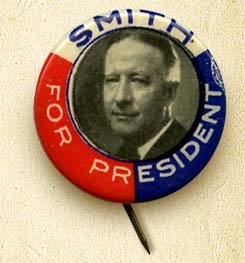What Al Smith Can Teach Mitt Romney

Al Smith 1928 presidential campaign button.
Those following Mitt Romney in the news may have noticed the frequency with which the former Massachusetts governor’s name has been linked to former New York governor Al Smith.
Eighty-four years ago, Smith was the Democratic candidate in the 1928 presidential election, which he lost in a landslide to his Republican opponent, Herbert Hoover. Looking forward to this November’s contest, more than a few historically-minded journalists have suggested that Smith’s miserable showing might augur something for Romney when he challenges Barack Obama for the presidency in a few months’ time.
Why the comparison is relevant is that it allegedly set the precedent for first-of-their-kind religious outsiders seeking the Oval Office, and Smith, the first Roman Catholic in American history to headline a major party’s presidential nomination, saw his campaign wilt under a glare of virulent anti-Catholic hysteria. As a member of the Church of Jesus Christ of Latter-day Saints (better known as the Mormons), Romney may have to endure something similar, and, we are told, is probably doomed to suffer the same outcome as Smith.
Yet a closer look at the last presidential tilt of the Roaring Twenties reveals that the fable of Smith as the capable candidate stymied by a bigoted electorate simply doesn’t fit the facts. Ascribing Smith’s defeat to his religion ignores his opponent’s considerable electoral appeal and assumes, wrongly, that religious bigotry worked in only one direction.
So what considerations came into play when Americans went to the polls in 1928? First the GOP boasted a star candidate in Secretary of Commerce Herbert Hoover (unbelievable as it may seem today).
In 1928, voters could scarcely have asked for a stronger contender than the hefty Iowan, who by that time had more than distinguished himself on several fronts. In business, he was a self-made mining tycoon with holdings on six continents. As a humanitarian, he masterminded the American relief effort in Europe during and after World War I, the aftermath of the Russian Civil War, and on the Mississippi River in the disastrous 1927 flood. And as an administrator, he single-handedly transformed a moribund Commerce Department into one of the most dynamic and effective offices of the federal government.
Altogether, Hoover circa 1928 was nothing less than an exceptional candidate for president. Voters had plenty of reasons to vote for him that had nothing to do with fear of a Catholic in the White House.
But if religion was not the principal factor in deciding the 1928 election, did it at least slant the playing field against Smith? Perhaps not. Certainly, anti-Catholic pamphlets warning of absurd and chimerical conspiracies from Rome were in no short supply that year. But one should not overlook that Hoover was also not a mainstream Protestant: he was a lifelong Quaker, and like Smith, suffered many scurrilous calumnies because of his faith. An anonymous circular distributed a month before the election, for example, accused the Friends of cravenly goldbricking their military duties during World War I, and went on to claim that the Quaker testimony of pacifism rendered Hoover unfit to serve as Commander-in-Chief.
In short, mainline Protestant voters committed to electing one of their own would have found themselves stuck between a rock and a hard place, with no particular reason to choose one candidate over the other.
One final observation tells the story: among the forty states returning for Hoover on election night was New York, Smith’s home state. The New York voters, who had previously elected Smith to three consecutive terms as governor, clearly had no qualms against casting their ballots for a Catholic and putting him in high office; that Smith failed to win over even this group speaks to the fact that his defeat was not due to religious bigotry, but rather the quality of the candidates.
In truth, anti-Catholic sentiment probably had little impact on the outcome of the 1928 election -- Smith lost because he could not match his opponent’s impressive credentials, not because of where he went to worship on Sundays. Consequently, a glance back at 1928 does not tell us much about Romney’s chances against president Obama when the two mix matters in November. Nevertheless, if we insist on regarding it as a dress rehearsal for such a showdown, it leaves us with the reassuring thought that the better candidate is likely to come out on top.
